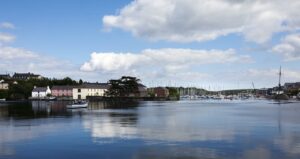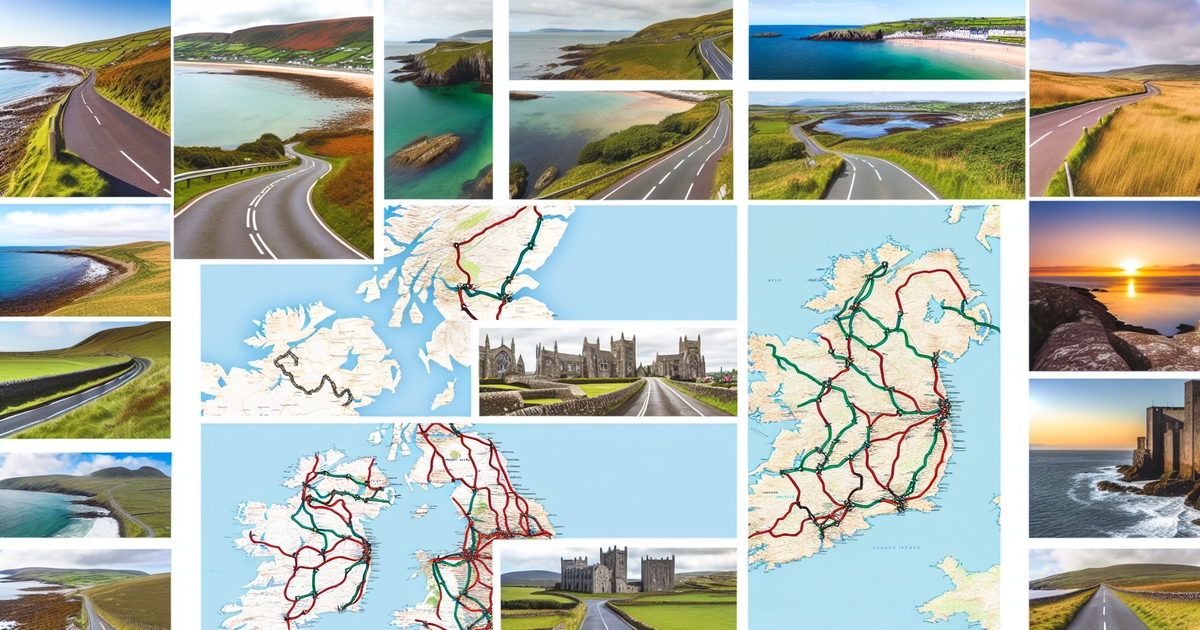- Key Takeaways
- North Coast 500
- Cotswolds Scenic Drive
- Wild Atlantic Way
- Norfolk Coastal Drive
- Atlantic Highway
- Yorkshire Road Trip
- Lake District Drive
- Wales Scenic Drives
- Causeway Coastal Route
- Peak District Journey
- Final Remarks
- Frequently Asked Questions
- What is the best time to drive the North Coast 500?
- Are there any tolls on the Cotswolds Scenic Drive?
- How long does it take to drive the Wild Atlantic Way?
- Is the Norfolk Coastal Drive suitable for caravans?
- What highlights can I expect on the Atlantic Highway?
- Are there good hiking spots on the Yorkshire Road Trip?
- Can I complete the Lake District Drive in one day?
Ever wondered where the best driving trips in the UK are? Discovering the UK by car offers stunning landscapes, historic sites, and hidden gems. Whether you fancy coastal roads or countryside routes, there’s something for everyone. From the scenic Scottish Highlands to the picturesque Cornish coast, each journey promises unique experiences.
Driving through the UK allows you to explore at your own pace. Imagine winding roads, breathtaking views, and charming villages. These top driving trips will make your adventure unforgettable. Ready to hit the road and uncover the UK’s finest routes? Let’s dive into the ultimate guide to UK top driving trips.
Key Takeaways
- Plan Your Route: Research and plan your driving trip ahead of time to ensure you hit all the key spots, like the North Coast 500 or the Wild Atlantic Way.
- Pack Essentials: Bring along essential items such as maps, snacks, and a first-aid kit to make your journey comfortable and safe.
- Check Your Vehicle: Ensure your vehicle is in good condition before embarking on drives like the Atlantic Highway or the Lake District Drive.
- Local Attractions: Take time to explore local attractions and hidden gems along routes like the Cotswolds Scenic Drive and the Norfolk Coastal Drive.
- Weather Ready: Be prepared for changing weather conditions, especially in areas like Wales Scenic Drives and the Peak District Journey.
- Enjoy the Scenery: Take breaks to enjoy the stunning landscapes, whether you’re on the Yorkshire Road Trip or the Causeway Coastal Route.
North Coast 500
Route Overview
The North Coast 500 is often compared to Ireland’s Wild Atlantic Way. The Wild Atlantic Way is a 1,500-mile coastal highway that offers stunning views. It stretches from Donegal to Cork, showcasing dramatic cliffs and serene beaches.
Spring is the best time to travel on this route. During spring, wildflower meadows bloom and create a picturesque landscape. The weather is also mild, making it perfect for long drives.
To fully explore the North Coast 500, allocate at least two weeks. This allows time to visit key attractions and enjoy the scenic beauty without rushing.

Key Attractions
Loch Ness is a must-see on the North Coast 500. Known for its mythical monster, Loch Ness offers boat tours and beautiful views. The Isle of Skye is another highlight. Famous for its rugged landscapes, it has picturesque villages and medieval castles.
On the Wild Atlantic Way, visit the Cliffs of Moher. These towering cliffs offer breathtaking views over the Atlantic Ocean. Galway, known for its vibrant culture and lively streets, is another key attraction.
Exmoor National Park is a gem on the Atlantic Highway. It features rolling hills, wooded valleys, and stunning coastlines. Land’s End marks the southwestern tip of England and offers dramatic sea views.
Best Stops
Kinloch Lodge is an ideal stop on the North Coast 500. This former hunting lodge offers comfortable rooms and fine dining. Lundies House in Tongue provides a cosy stay with modern amenities.
For those travelling along the Wild Atlantic Way, Delphi Lodge is highly recommended. Nestled in Connemara, it offers luxury accommodation and stunning views of Doo Lough.
Number One Bruton is a great place to stay on the Atlantic Highway. Located in Somerset, it combines historic charm with modern comfort. Idle Rocks in St Mawes offers luxury by the sea with excellent dining options.
Cotswolds Scenic Drive
Route Overview
The Cotswolds Scenic Drive offers a picturesque journey through the English countryside. Starting from Bath, the route winds through charming villages and rolling hills. The drive covers around 90 miles and takes about two hours without stops. However, plan for a full day to explore.
Driving through the Cotswolds, you’ll encounter narrow lanes and stunning landscapes. The route includes notable towns like Cirencester and Stow-on-the-Wold. Each location has unique attractions and local charm.
Must-See Villages
Ullapool and John O’Groats on the North Coast 500 are famous for their scenic beauty. In contrast, the Cotswolds boasts quaint villages such as Bibury and Bourton-on-the-Water. Bibury is known for Arlington Row, a row of ancient cottages.
Bourton-on-the-Water features low bridges over the River Windrush. It’s often called the “Venice of the Cotswolds.” Both villages offer picturesque settings perfect for photography.
Explore Kinsale and Connemara on the Wild Atlantic Way for rugged coastlines. Similarly, in the Cotswolds, visit Castle Combe. This village has been used as a filming location due to its timeless appearance.

Discover Port Isaac and Padstow on the Atlantic Highway for coastal charm. In the Cotswolds, Chipping Campden is a must-see. It has beautiful honey-coloured stone buildings and a historic market hall.
Historic Sites
Touring ancient castles on the North Coast 500 reveals Scotland’s rich history. Likewise, the Cotswolds is home to numerous historic sites. One notable site is Sudeley Castle near Winchcombe.
Sudeley Castle dates back to the 15th century and has royal connections. Visitors can explore its gardens and learn about its history through exhibits.
Visit historic sites like the Cliffs of Moher on the Wild Atlantic Way for breathtaking views. In comparison, Blenheim Palace in Woodstock offers grandeur and historical significance.
Blenheim Palace was built in the early 18th century. It is a UNESCO World Heritage Site and birthplace of Winston Churchill.
Explore heritage sites such as Tintagel Castle on the Atlantic Highway for legendary tales. Similarly, Broadway Tower in Worcestershire provides panoramic views and historical context.
Broadway Tower was designed by James Wyatt in 1794. It stands 65 feet tall and offers insights into England’s past.
Wild Atlantic Way
Route Overview
The Wild Atlantic Way is a stunning drive along Ireland’s west coast. It stretches over 2,500 kilometres. The route begins in Donegal and ends in Cork. Drivers experience diverse landscapes and breathtaking views.
This route has many winding roads and coastal paths. It offers an adventure for those seeking natural beauty. Travellers can explore charming villages and historical sites.
Coastal Highlights
Drive along Donegal beaches on the Wild Atlantic Way. The golden sands and clear waters are perfect for a peaceful stop. Malin Head, Ireland’s most northerly point, offers dramatic cliffs and panoramic views.
Enjoy the coastal scenery of Bude and Padstow on the Atlantic Highway. These Cornish towns have picturesque harbours and sandy beaches. Bude is known for its surfing spots, while Padstow boasts seafood restaurants.
Experience the rugged coastline of the Causeway Coastal Route. This Northern Irish drive features the Giant’s Causeway, a UNESCO World Heritage site. The basalt columns create a unique landscape worth visiting.
Activities and Stops
Engage in watersports in Wales during summer. Pembrokeshire’s beaches offer surfing, kayaking, and paddleboarding. Newgale Beach is a popular spot for windsurfing due to its strong winds.
Take scenic stop-offs at Pen y Fan and Solva Harbour. Pen y Fan, the highest peak in South Wales, provides hiking trails with stunning views. Solva Harbour is a quaint fishing village with colourful cottages and boats.
Relax at The Grove of Narberth and The Harbourmaster. The Grove of Narberth is a luxurious hotel set in beautiful grounds, ideal for unwinding after a long drive. The Harbourmaster in Aberaeron offers comfortable rooms and delicious local cuisine.
Norfolk Coastal Drive
Route Overview
The Norfolk Coastal Drive offers a scenic route along the eastern coast of England. This drive covers around 90 miles, starting from King’s Lynn and ending at Great Yarmouth. The route takes you through charming villages, sandy beaches, and stunning landscapes.
Travellers can enjoy picturesque views of the North Sea. The journey includes stops at Hunstanton, Wells-next-the-Sea, and Cromer. Each town has unique attractions and beautiful coastal scenery.
Coastal Towns
Hunstanton is known for its striking red and white striped cliffs. Visitors can explore the beach and visit the Sea Life Sanctuary.
Wells-next-the-Sea boasts a bustling harbour and colourful beach huts. It is perfect for a leisurely stroll along the quay or bird watching.
Cromer is famous for its pier and fresh crab. The town offers a mix of traditional seaside fun and historic buildings.
Nature Reserves
The Norfolk Coastal Drive passes several nature reserves. These spots are ideal for wildlife enthusiasts.
RSPB Titchwell Marsh is home to various bird species. Visitors can follow walking trails to observe avocets, bitterns, and marsh harriers.
Blakeney National Nature Reserve offers salt marshes and sand dunes. It is a great place to see seals basking on the shores.
Holkham National Nature Reserve features vast sandy beaches and pine forests. It provides a habitat for many rare plants and animals.
Atlantic Highway
Route Overview
The Atlantic Highway, also known as the A39, stretches from Barnstaple in Devon to Fraddon in Cornwall. This route covers around 70 miles. It offers stunning coastal views and picturesque landscapes. The road is a popular choice for those looking to explore the South West of England.
This highway passes through charming towns and villages. Some notable stops include Bude, Boscastle, and Tintagel. Each location has its own unique attractions and history. The route also provides access to several beaches and coastal paths.
Scenic Sections
One of the highlights of the Atlantic Highway is its scenic sections. Driving through the Brecon Beacons in Wales offers breathtaking views of rolling hills and valleys. This area is known for its natural beauty and outdoor activities.
Another scenic section is the North Coast 500 in Scotland. This route includes stunning coastal views and rugged landscapes. Enjoying the scenic sections of the North Coast 500 can make any driving trip memorable.
The Wild Atlantic Way in Ireland is also worth mentioning. Experiencing the picturesque landscapes of the Wild Atlantic Way can be a highlight of any trip. This route features dramatic cliffs, sandy beaches, and charming villages.
Top Attractions
There are many top attractions along the Atlantic Highway. Visiting Loch Ness and Isle of Skye on the North Coast 500 offers a chance to see some of Scotland’s most famous landmarks. Loch Ness is known for its legendary monster, while the Isle of Skye boasts stunning landscapes.
In Ireland, exploring the Cliffs of Moher and Galway on the Wild Atlantic Way provides breathtaking views and rich cultural experiences. The Cliffs of Moher are one of Ireland’s most visited natural attractions.
On the Atlantic Highway itself, discovering Exmoor National Park and Land’s End is a must. Exmoor National Park offers diverse wildlife and scenic walking trails. Land’s End is the westernmost point of mainland England, providing dramatic ocean views.
Yorkshire Road Trip
Route Overview
The Yorkshire road trip offers a scenic drive through the heart of England. The journey starts in York, a city with rich history. Travel north towards the Yorkshire Dales. The roads are well-maintained and offer stunning views. Pass through charming villages like Grassington and Hawes. Continue to the Lake District for breathtaking landscapes.
Drive along the A59 and A65 routes. These roads provide access to various attractions. The entire trip covers approximately 150 miles. It is perfect for a weekend getaway. Enjoy the mix of history, nature, and culture.
National Parks
Explore the Yorkshire Dales National Park on this trip. It is known for its limestone cliffs and rolling hills. Visit Malham Cove, a natural limestone formation. Hike around Ingleborough, one of the Three Peaks.
Head towards North York Moors National Park next. This park features heather moorland and coastal scenery. Drive through the Hole of Horcum, a large natural amphitheatre. Stop by Whitby Abbey, an ancient ruin with stunning views.
Discover Exmoor National Park along the Atlantic Highway mentioned earlier. This park spans both Devon and Somerset counties. It offers coastal walks and rugged landscapes.
Visit national parks along the Wild Atlantic Way in Ireland if extending your trip. These parks include Killarney National Park and Connemara National Park. They showcase Ireland’s natural beauty with mountains and lakes.
Finally, explore the natural beauty of the Brecon Beacons in Wales. Although not in Yorkshire, it is worth mentioning for its scenic drives. The park features waterfalls, caves, and rolling hills.
Historic Sites
Yorkshire is rich in history with many sites to visit. Start with York Minster, a Gothic cathedral dating back to 627 AD. It is one of the largest cathedrals in Northern Europe.
Next, visit Fountains Abbey near Ripon. Founded in 1132, it is a UNESCO World Heritage site. The abbey ruins are set in beautiful grounds with water gardens.
Stop by Bolton Castle in Wensleydale. Built in 1399, it offers insights into medieval life. Mary, Queen of Scots was once imprisoned here.
Drive to Castle Howard near Malton. Completed in 1712, it remains one of Britain’s finest stately homes. The house has extensive gardens and a grand architecture.
Lake District Drive
Route Overview
The Lake District offers a stunning driving experience. Known for its breathtaking scenery, it is a UNESCO World Heritage site. The drive covers around 30 miles, starting from Kendal and ending in Keswick.
The route takes you through charming towns like Windermere and Ambleside. Each town has unique attractions and local shops. The roads are well-maintained but can be narrow in places.
Scenic Routes
Drive through the scenic routes of the North Coast 500. This route spans 516 miles around the northern coast of Scotland. It offers views of rugged landscapes and coastal cliffs.
Enjoy the picturesque landscapes of the Wild Atlantic Way. This route stretches along Ireland’s west coast for over 1,500 miles. It features dramatic cliffs, sandy beaches, and quaint villages.
Experience the beautiful coastal roads of the Atlantic Highway. This route runs along England’s southwest coast. It provides stunning views of the sea and countryside.
Outdoor Activities
Engage in watersports in Wales during summer. Popular activities include kayaking, sailing, and windsurfing. Pembrokeshire is a top spot for these sports.
Hike and explore nature reserves along the Wild Atlantic Way. There are numerous trails for all levels of hikers. Connemara National Park is a must-visit.
Participate in outdoor adventures on the North Coast 500. Activities include mountain biking, fishing, and wildlife spotting. Torridon is famous for its challenging bike trails.
Wales Scenic Drives
Route Overview
Wales offers some of the most picturesque driving routes in the UK. The landscape is diverse, featuring mountains, valleys, and coastal roads. Each route provides unique experiences for drivers and passengers alike.
One notable route is the A470. This road stretches from Cardiff to Llandudno. It covers a distance of 186 miles. Along the way, you will pass through the Brecon Beacons National Park. The park is known for its stunning scenery and wildlife.
Another popular drive is the Black Mountain Pass. This road is famous among car enthusiasts. It offers challenging twists and turns. The views from this pass are breathtaking.
Mountain Passes
Mountain passes in Wales provide thrilling drives. One such pass is the Llanberis Pass. Located in Snowdonia National Park, it offers dramatic landscapes. The pass winds through steep valleys and rocky cliffs.
Drivers can also explore the Bwlch y Groes. This is one of the highest roads in Wales. It reaches an elevation of 545 metres. The climb is steep and narrow, requiring careful navigation.
In comparison, mountain passes in other parts of the UK offer different experiences. For example, the North Coast 500 in Scotland takes you through the Scottish Highlands. This route features rugged terrain and scenic views.
The Wild Atlantic Way in Ireland also offers impressive mountain passes. Drivers navigate winding roads with stunning ocean vistas. These routes are similar to those found in Wales but with their own unique charm.
Coastal Roads
Wales boasts some beautiful coastal roads as well. The A487 runs along the west coast of Wales. It offers views of Cardigan Bay and the Irish Sea.
A must-see section of this road is near Aberystwyth. Here, drivers can enjoy panoramic ocean views. The road also passes through charming seaside towns and villages.
Another notable coastal drive is the Gower Peninsula route. This area was designated as the UK’s first Area of Outstanding Natural Beauty in 1956. The route includes stunning beaches like Rhossili Bay and Three Cliffs Bay.
Comparatively, coastal roads in other regions also offer spectacular drives. For instance, the Atlantic Highway in England provides scenic coastline views along its route.
Similarly, the Wild Atlantic Way in Ireland features rugged coastal landscapes. Drivers experience dramatic cliffs and picturesque beaches.
The Causeway Coastal Route in Northern Ireland also stands out for its beauty. This route includes iconic landmarks like Giant’s Causeway and Carrick-a-Rede Rope Bridge.
Causeway Coastal Route
Route Overview
The Causeway Coastal Route stretches from Belfast to Derry. It covers approximately 120 miles of stunning coastline. This route is known for its dramatic landscapes and historic sites.
Travellers can expect a mix of rugged cliffs, sandy beaches, and charming villages. The journey is ideal for those who love nature and history. It offers plenty of opportunities to stop and explore.
Driving along this route takes around three hours without stops. However, most people take longer to enjoy the sights. It’s recommended to plan for a full day or even two.
Key Landmarks
One of the main attractions on this route is the Giant’s Causeway. This UNESCO World Heritage site features unique basalt columns formed by volcanic activity.
Another must-see landmark is Carrick-a-Rede Rope Bridge. This bridge connects the mainland to a small island and offers stunning views.
The Dark Hedges, famous from the Game of Thrones series, is also on this route. It’s an avenue of beech trees that create a natural tunnel effect.
In addition to these, visit Dunluce Castle. Perched on a cliff edge, this medieval castle has a rich history and breathtaking views.
Best Viewpoints
Several viewpoints along the Causeway Coastal Route offer spectacular scenery. One popular spot is Torr Head. From here, you can see Scotland on a clear day.
Another great viewpoint is Fair Head. It provides panoramic views of the coast and the sea beyond.
Don’t miss the viewpoint at Ballintoy Harbour. This picturesque harbour has been used as a filming location for several movies and TV shows.
Lastly, make sure to stop at Mussenden Temple. This small building sits on a cliff edge and offers stunning views of the Atlantic Ocean.
Peak District Journey
Route Overview
The Peak District offers a scenic route for driving enthusiasts. Starting from Derby, the journey covers towns like Bakewell and Buxton. The route spans approximately 50 miles. It showcases breathtaking landscapes and picturesque villages.
There are numerous places to stop along the way. Chatsworth House is a must-see. This grand estate has beautiful gardens and art collections. Another highlight is the Monsal Head viewpoint. It provides stunning views of the Monsal Dale valley.
Hiking Trails
The Peak District is known for its excellent hiking trails. One popular trail is the Pennine Way. It stretches over 268 miles, starting in Edale. This trail offers diverse scenery, including moorlands and limestone cliffs.
Another notable trail is the Kinder Scout hike. It leads to the highest point in the Peak District at 636 metres. The hike can be challenging but rewards with panoramic views.
For those seeking shorter walks, try the Dovedale trail. It features stepping stones across the River Dove and limestone ravines.
Historic Villages
Historic villages dot the Peak District landscape. One such village is Castleton. It’s famous for its caverns and Blue John stone. Visitors can explore Peveril Castle, which dates back to 1086.
Another charming village is Eyam, known as the “Plague Village”. In 1665, villagers quarantined themselves during a plague outbreak. Today, visitors can learn about this history at the Eyam Museum.
Bakewell is also worth a visit. It’s home to the famous Bakewell pudding and has a historic market dating back to 1254.
Final Remarks
You’ve now got a treasure trove of the UK’s top driving trips at your fingertips. From the rugged beauty of the North Coast 500 to the serene landscapes of the Lake District, each journey promises unforgettable memories and stunning scenery. Whether you’re seeking adventure or a peaceful retreat, there’s a route just for you.
ack your bags, fuel up your car, and hit the road. Experience these breathtaking drives firsthand. Share your stories and inspire others to embark on their own road trip adventures. Safe travels!
Frequently Asked Questions
What is the best time to drive the North Coast 500?
The best time is from May to September. The weather is mild, and the roads are clear.
Are there any tolls on the Cotswolds Scenic Drive?
No, there are no tolls on the Cotswolds Scenic Drive. Enjoy a free and scenic journey.
How long does it take to drive the Wild Atlantic Way?
It takes around 2-3 weeks to fully experience the Wild Atlantic Way. Plan for ample stops.
Is the Norfolk Coastal Drive suitable for caravans?
Yes, the Norfolk Coastal Drive is caravan-friendly. There are plenty of caravan parks along the route.
What highlights can I expect on the Atlantic Highway?
Expect stunning coastal views, charming villages, and historical landmarks. Don’t miss Tintagel Castle.
Are there good hiking spots on the Yorkshire Road Trip?
Absolutely! The Yorkshire Dales offer excellent hiking trails with breathtaking scenery.
Can I complete the Lake District Drive in one day?
Yes, but it’s better to spread it over 2-3 days to fully enjoy the sights and activities.





